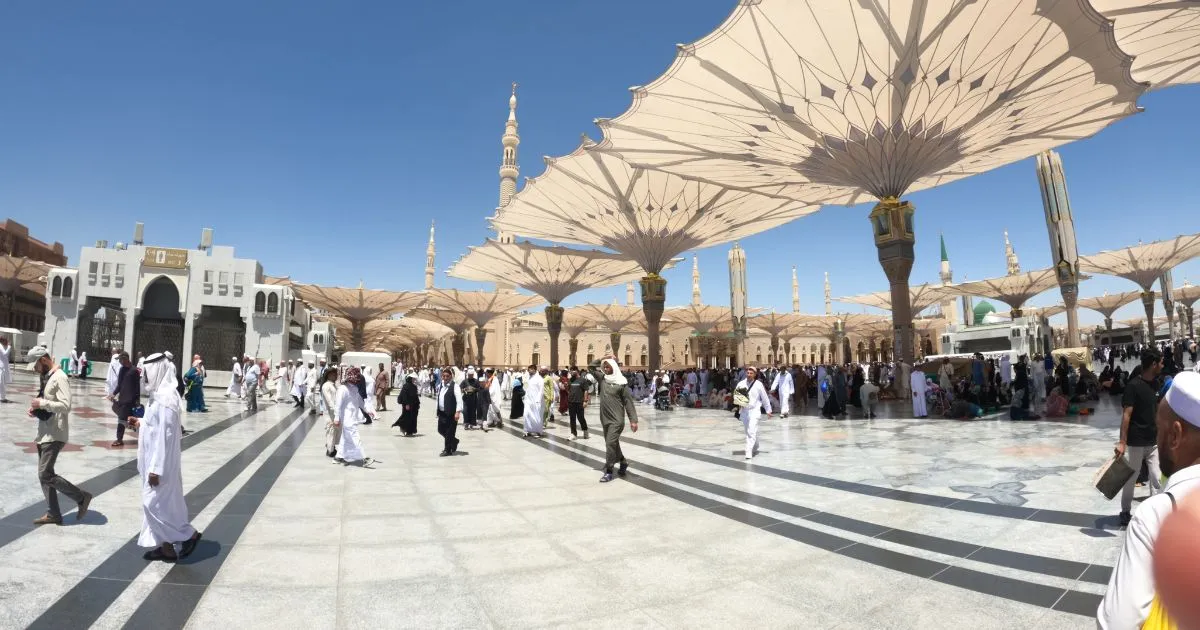Navigating Masjid an-Nabawi A Guide to the Gates, Courtyards, and Facilities of Masjid an-Nabawi
Table of Contents
Navigating Masjid an-Nabawi A Guide to the Gates, Courtyards, and Facilities of Masjid an-Nabawi
For every pilgrim and visitor, standing before the immense beauty of Masjid an-Nabawi in Medina is a profoundly moving experience. Its vastness, however, can be daunting. With a capacity exceeding one million worshippers, how does one navigate this architectural marvel? The answer lies in a brilliantly simple and intuitive system of numbering and color-coding.
This guide deciphers the logic behind Masjid an-Nabawi’s wayfinding systems, empowering you to navigate the mosque with confidence, find your loved ones with ease, and access facilities without stress.
The Grand Entrance: Understanding the 41 Main Gates
The primary gates are your main entry and exit points to the covered prayer hall. Their numbering system is the cornerstone of navigation.
The Logic: The gates are numbered sequentially in a counter-clockwise direction, starting from the northern wall. This creates a predictable, logical flow around the entire mosque complex.
- Gate 1 to Gate 12 (& 41): The Northern Side. This is the newest section, from the King Abdullah Expansion. It features the highest density of gates to manage the immense flow of people from parking areas and new facilities.
- Gate 13 to Gate 22: The Eastern Side. This side faces the old city and includes historically significant gates named after Saudi monarchs.
- Gate 23 to Gate 32: The Southern Side (Qiblah Wall). This is the most sacred side, housing the Rawdah ash-Sharifah (the Garden from Paradise) and the Prophet’s Tomb. Gates here are crucial for pilgrims wishing to visit these holy sites.
- Gate 33 to Gate 40: The Western Side. This side borders major hotels and incorporates sections from the Ottoman era.
Why It Matters: The number is your quickest location identifier. If your group agrees to meet at Gate 5, everyone knows to go to the northern side. A message saying “I’m lost near Gate 28” immediately tells security or family that you are on the southern side. This system eliminates all ambiguity and is the most effective way to coordinate in a crowd of thousands.
The Expansive Courtyards: Mastering the 70+ Color-Coded Gates
The open-air plazas surrounding the main mosque are called the courtyards or Azan Courts, used for overflow prayer. Their numbering system is even more detailed, using a hierarchical color-and-number combination.
The Logic: The system is designed for precision across a massive scale.
- Color by Side: Each of the four sides of a major courtyard is assigned a specific color. For example:
- Northern Side: Blue
- Eastern Side: Green
- Southern Side: Yellow
- Western Side: Red
- Numbered Gates: The gates on each colored side are then numbered sequentially.
Why It Matters: This two-tiered system is incredibly powerful. A meeting point at “Yellow Gate 5” is unmistakable. The color (Yellow) instantly narrows your search to one specific side of the courtyard, and the number (5) pinpoints the exact entrance. This is essential for finding family and friends after prayer in the vast open spaces.
The Essential Facilities: Locating Toilets and Ablution Areas
The restroom and wudu (ablution) facilities are located underground, and their numbering system is seamlessly integrated with the main gates for maximum convenience.
The Logic: Proximity. The facility areas are named after the main gate they are located beneath.
- If you enter the underground facilities near Main Gate 15, you will find all signs pointing to “Area 15” for toilets and ablution.
- Exits from the facilities will clearly guide you back up to the same gate number.
Distribution and Accessibility: The facilities are evenly distributed beneath the entire complex, ensuring you are never far from one.
- For People with Disabilities: Masjid an-Nabawi is exceptionally well-equipped for all visitors. In every toilet block, you will find:
- Spacious accessible cabins clearly marked with the international wheelchair symbol.
- Support rails and lower-height fixtures.
- Seated ablution stations for those who cannot perform wudu while standing.
- Emergency call buttons for assistance.
These features ensure that every individual can perform their ablution and use the facilities with dignity, ease, and independence.
Conclusion: A System Built for Peace of Mind
The numbering and color-coding of Masjid an-Nabawi are not mere logistics; they are a testament to the thoughtful, user-centered design that prioritizes the comfort and convenience of every guest. This intricate system transforms a potentially overwhelming complex into a navigable and peaceful spiritual haven.
By understanding this simple logic—main gates numbered clockwise, courtyards identified by color and number, and facilities linked to gate numbers—you can focus less on worrying about getting lost and more on the profound spiritual experience that awaits you in the Prophet’s Mosque.
Pro Tip: Upon arrival, take a picture of the gate you enter from. This will be your visual reference point for your entire visit.

